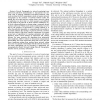1629 search results - page 94 / 326 » Infeasible Code Detection |
ACSAC
2010
IEEE
14 years 6 months ago
2010
IEEE
Heap spraying is an attack technique commonly used in hijacking browsers to download and execute malicious code. In this attack, attackers first fill a large portion of the victim...
INFOCOM
2009
IEEE
15 years 4 months ago
2009
IEEE
—The performance of randomized network coding can suffer significantly when malicious nodes corrupt the content of the exchanged blocks. Previous work have introduced error corr...
114
click to vote
TVLSI
2010
14 years 4 months ago
2010
Program code in a computer system can be altered either by malicious security attacks or by various faults in microprocessors. At the instruction level, all code modifications are ...
ICMCS
2006
IEEE
15 years 3 months ago
2006
IEEE
In this paper, we present a joint source-channel decoding technique based on exact MAP estimation for data encoded by CABAC (Context-based Adaptive Binary Arithmetic Coding) in st...
INFOCOM
2010
IEEE
14 years 8 months ago
2010
IEEE
—Network Tomography (or network monitoring) uses end-to-end path-level measurements to characterize the network, such as topology estimation and failure detection. This work prov...

